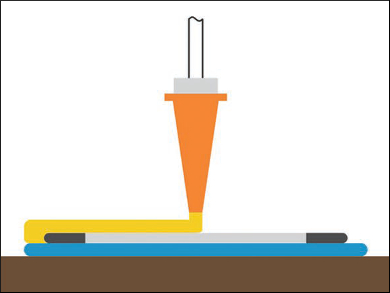Flexible electronics could be useful for applications such as wearable tech and medical implants. While many prototypes have been prepared, the mass production of bendable and stretchable electronic circuits is still a challenge. One approach to making flexible circuits is using liquid metals, e.g., eutectic alloys of gallium and indium. However, these alloys have a high surface tension and are difficult to process.
Mohammed G. Mohammed and Rebecca Kramer, Purdue University, West Lafayette, IN, USA, have developed a manufacturing process for printing flexible electronics made from silicone elastomers and liquid metal. The team first nozzle-printed a base layer of elastomer using Smooth-Sil® 950 silicone (pictured blue) on a glass slide. They then prepared a slurry of eutectic gallium/indium alloy microparticles in isopropanol by sonication. This makes the alloy easier to process. The team used the slurry as ink to spray-print a metal film over the silicone layer. The metal layer’s conductivity was then activated in the desired places by tapping it with a nozzle, which sinters the metal particles together. In a final step, the team sealed the device with Sylgard® 184 silicone (pictured yellow).
The researchers tested the fabrication process in the production of pressure sensors and stretchable wires. They found a yield of 75 % working printed devices. The printing processes for simple geometries take about 15 minutes, however, curing the elastomers increases production time to over six hours. Heating the material to 60°C can shorten this time to about two hours. According to the team, further optimization of the process could allow it to be used in commercial applications.
- All-Printed Flexible and Stretchable Electronics,
Mohammed G. Mohammed, Rebecca Kramer,
Adv. Mater. 2017.
DOI: 10.1002/adma.201604965


![Synthesis of [c2]Daisy Chains via Mechanochemistry](https://www.chemistryviews.org/wp-content/uploads/2025/04/202504_RotaxanesWithSolidStateMechanochemistry-125x94.png)

